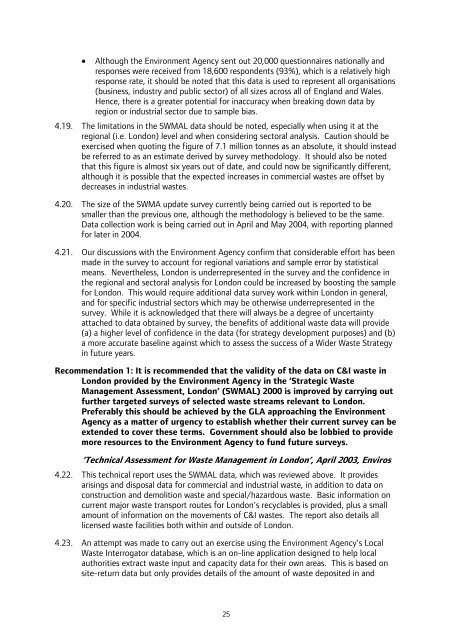London Wider Waste Strategy - London - Greater London Authority
London Wider Waste Strategy - London - Greater London Authority
London Wider Waste Strategy - London - Greater London Authority
Create successful ePaper yourself
Turn your PDF publications into a flip-book with our unique Google optimized e-Paper software.
• Although the Environment Agency sent out 20,000 questionnaires nationally and<br />
responses were received from 18,600 respondents (93%), which is a relatively high<br />
response rate, it should be noted that this data is used to represent all organisations<br />
(business, industry and public sector) of all sizes across all of England and Wales.<br />
Hence, there is a greater potential for inaccuracy when breaking down data by<br />
region or industrial sector due to sample bias.<br />
4.19. The limitations in the SWMAL data should be noted, especially when using it at the<br />
regional (i.e. <strong>London</strong>) level and when considering sectoral analysis. Caution should be<br />
exercised when quoting the figure of 7.1 million tonnes as an absolute, it should instead<br />
be referred to as an estimate derived by survey methodology. It should also be noted<br />
that this figure is almost six years out of date, and could now be significantly different,<br />
although it is possible that the expected increases in commercial wastes are offset by<br />
decreases in industrial wastes.<br />
4.20. The size of the SWMA update survey currently being carried out is reported to be<br />
smaller than the previous one, although the methodology is believed to be the same.<br />
Data collection work is being carried out in April and May 2004, with reporting planned<br />
for later in 2004.<br />
4.21. Our discussions with the Environment Agency confirm that considerable effort has been<br />
made in the survey to account for regional variations and sample error by statistical<br />
means. Nevertheless, <strong>London</strong> is underrepresented in the survey and the confidence in<br />
the regional and sectoral analysis for <strong>London</strong> could be increased by boosting the sample<br />
for <strong>London</strong>. This would require additional data survey work within <strong>London</strong> in general,<br />
and for specific industrial sectors which may be otherwise underrepresented in the<br />
survey. While it is acknowledged that there will always be a degree of uncertainty<br />
attached to data obtained by survey, the benefits of additional waste data will provide<br />
(a) a higher level of confidence in the data (for strategy development purposes) and (b)<br />
a more accurate baseline against which to assess the success of a <strong>Wider</strong> <strong>Waste</strong> <strong>Strategy</strong><br />
in future years.<br />
Recommendation 1: It is recommended that the validity of the data on C&I waste in<br />
<strong>London</strong> provided by the Environment Agency in the ‘Strategic <strong>Waste</strong><br />
Management Assessment, <strong>London</strong>’ (SWMAL) 2000 is improved by carrying out<br />
further targeted surveys of selected waste streams relevant to <strong>London</strong>.<br />
Preferably this should be achieved by the GLA approaching the Environment<br />
Agency as a matter of urgency to establish whether their current survey can be<br />
extended to cover these terms. Government should also be lobbied to provide<br />
more resources to the Environment Agency to fund future surveys.<br />
‘Technical Assessment for <strong>Waste</strong> Management in <strong>London</strong>’, April 2003, Enviros<br />
4.22. This technical report uses the SWMAL data, which was reviewed above. It provides<br />
arisings and disposal data for commercial and industrial waste, in addition to data on<br />
construction and demolition waste and special/hazardous waste. Basic information on<br />
current major waste transport routes for <strong>London</strong>’s recyclables is provided, plus a small<br />
amount of information on the movements of C&I wastes. The report also details all<br />
licensed waste facilities both within and outside of <strong>London</strong>.<br />
4.23. An attempt was made to carry out an exercise using the Environment Agency’s Local<br />
<strong>Waste</strong> Interrogator database, which is an on-line application designed to help local<br />
authorities extract waste input and capacity data for their own areas. This is based on<br />
site-return data but only provides details of the amount of waste deposited in and<br />
25
















